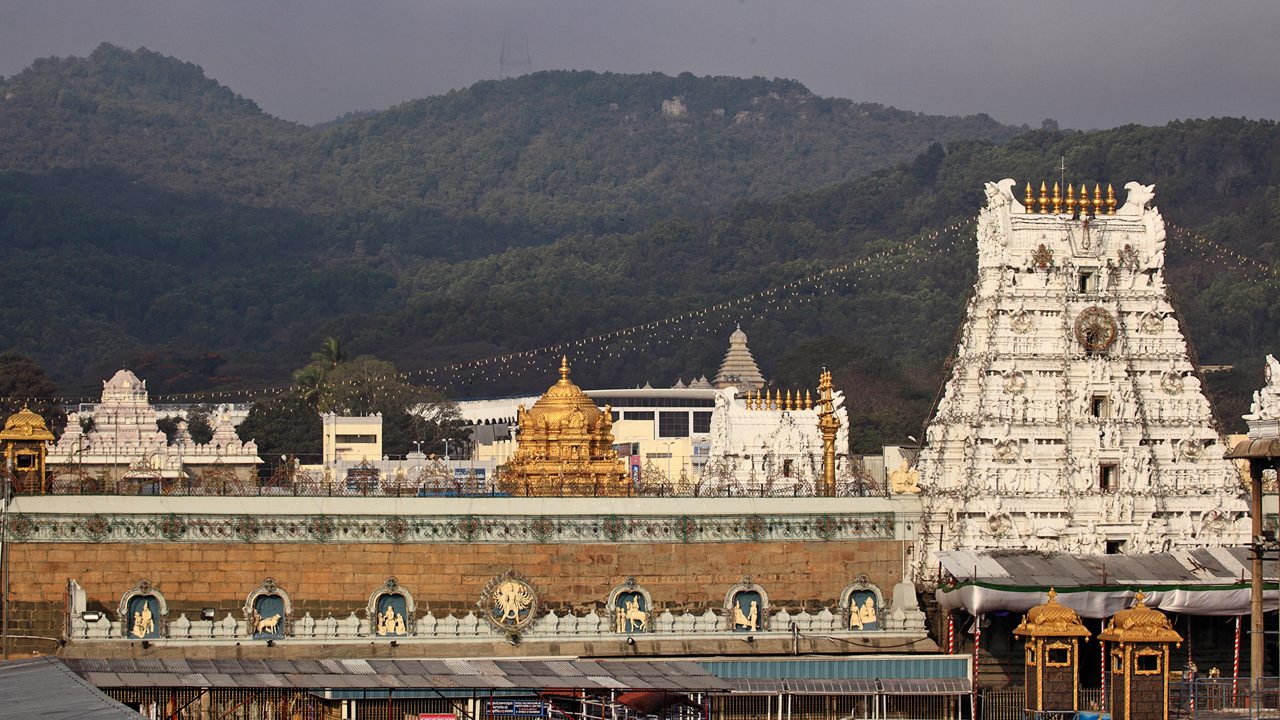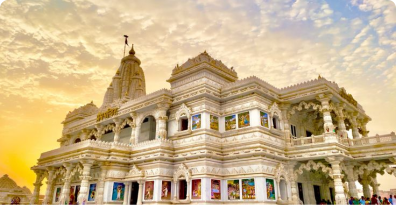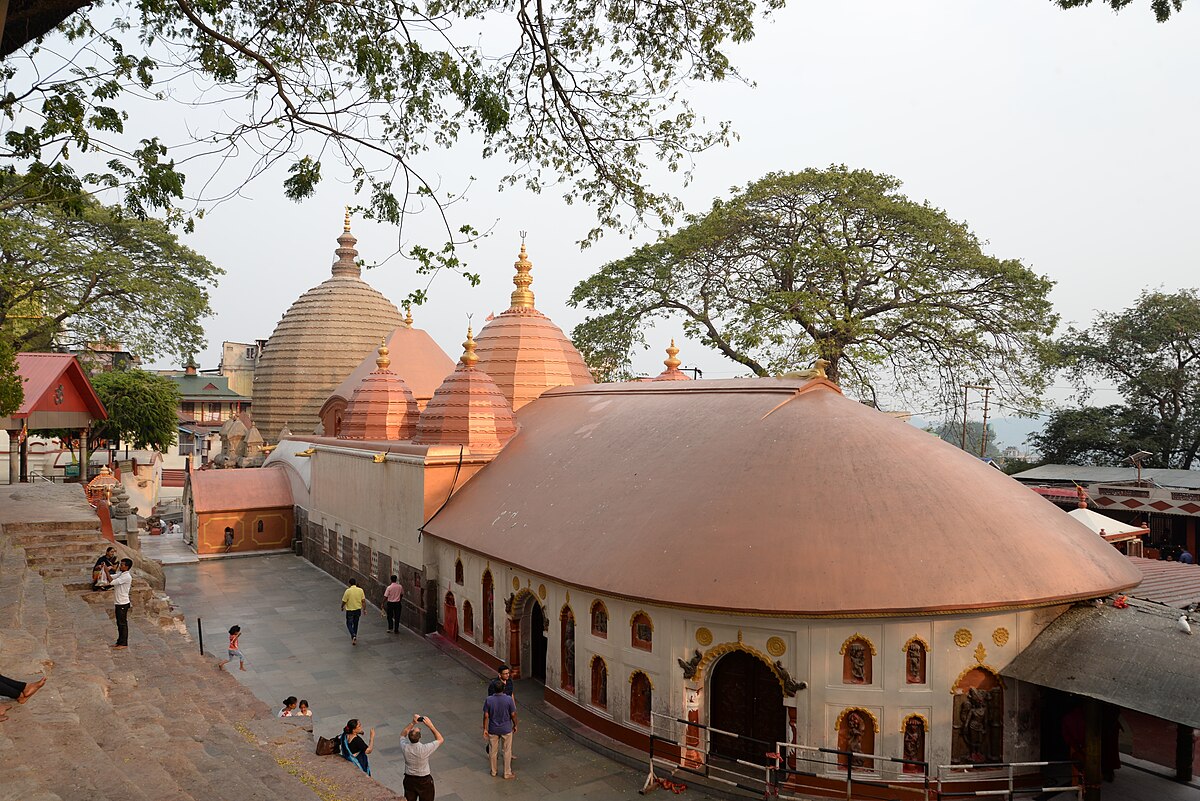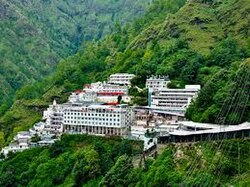
October 06, 2025
Temple Mandir
6 min read
Tirupati Balaji Temple
Perched atop the scenic Tirumala Hills in Andhra Pradesh, the Tirupati Balaji Temple is one of the most visited and revered pilgrimage sites in the world. Dedicated to Lord Venkateswara, an incarnation of Lord Vishnu, the temple is renowned for its spiritual energy, grand architecture, and centuries-old rituals. Legends say that the deity manifested here to bless devotees and fulfill their deepest desires, attracting millions of pilgrims every year. Beyond its religious significance, the temple is famous for the “Laddu Prasadam”, a divine offering that devotees cherish. A visit to Tirupati Balaji is more than just a journey; it’s an experience of faith, devotion, and the timeless charm of South Indian spiritual heritage.
Tirupati Balaji Temple, Andhra Pradesh: The Divine Abode of Lord Venkateswara
Introduction
Tirupati Balaji Temple, also known as Sri Venkateswara Swamy Temple, is one of the most visited and revered temples in India, located in the Tirumala hills of Andhra Pradesh. Dedicated to Lord Venkateswara, an incarnation of Lord Vishnu, this temple is considered the ultimate destination for devotees seeking divine blessings, prosperity, and spiritual solace.
Nestled amidst seven sacred hills collectively called Saptagiri, Tirupati is not just a temple; it is a living testament to faith, devotion, and tradition. Millions of devotees from across the globe visit every year, making it a hub of spiritual energy and cultural heritage.
The temple’s popularity is immense because of its promise of fulfilling wishes. Devotees believe that offering prayers and making donations here removes obstacles in life and brings divine grace. Its fame is also linked to ancient legends, mysterious miracles, and centuries-old rituals that continue to mesmerize pilgrims.
Historical Background
The history of Tirupati Balaji Temple is deeply intertwined with mythology, dynasties, and royal patronage. Ancient scriptures like the Vishnu Purana and Varaha Purana mention the sacredness of the Saptagiri hills and the manifestation of Lord Venkateswara here.
According to legend, Lord Vishnu descended to Earth in this form to save mankind from the trials of the Kali Yuga, granting blessings and guiding devotees toward righteousness. The deity is affectionately called “Balaji” or “Govinda”, and the temple is often referred to as “Temple of Seven Hills”.
Historical records suggest that the temple was built and expanded by various South Indian dynasties, including the Cholas, Pallavas, and Vijayanagara rulers. King Krishnadevaraya of the Vijayanagara Empire is particularly celebrated for his contributions, including generous donations and temple renovations that enhanced its architectural beauty.
The temple complex today includes ancient sanctums, mandapams (halls), and gopurams (tower gateways), all crafted in the Dravidian architectural style, reflecting centuries of devotion, art, and cultural richness.
Myths & Stories
Tirupati Balaji Temple is surrounded by fascinating legends and spiritual stories that have enchanted devotees for centuries. One of the most famous myths is about Lord Vishnu borrowing money from Kubera (the god of wealth) to fund his marriage with Goddess Padmavati. It is said that devotees offer donations as a symbolic act of repaying this divine debt, which has created a unique spiritual economy of giving.
Another story tells of Goddess Lakshmi’s displeasure with Lord Vishnu for descending to Earth. She cursed him, saying that his feet would remain on Earth while he served humanity. This is believed to explain the Lord’s eternal presence in Tirumala, where he continues to bless devotees.
Local legends narrate miraculous incidents where devotees’ prayers were answered instantly, emphasizing the omnipotent grace of Lord Venkateswara. It is also believed that just seeing the deity with faith can remove sins and bring prosperity, making the temple a magnet for pilgrims worldwide.
Additionally, the temple’s pristine Gopuram and sanctum sanctorum are said to radiate spiritual energy that enhances meditation, inner peace, and divine connection, creating an aura of mystical presence.
Festivals & Rituals
Tirupati Balaji Temple is a hub of vibrant festivals and daily rituals. Among them, Brahmotsavam is the grandest, celebrated annually over nine days with colorful processions, music, and elaborate ceremonies. Devotees from all over India gather to witness this festival, which is said to attract millions of participants.
Other important celebrations include Vaikunta Ekadashi, Rathasapthami, and Pavitrotsavam, during which the deity is adorned in different forms, and special rituals are performed to ensure the well-being of devotees and the community.
Daily rituals at the temple follow a strict schedule. Suprabhatam (morning awakening of the Lord) begins the day, followed by Archana, Abhishekam, and Sevas like Sahasranama Archana. The highlight is the Kalyanotsavam (divine wedding ceremony) performed for the deity, symbolizing eternal love and prosperity.
A distinctive feature of Tirupati is the laddu prasadam, a sweet offering that has been declared a geographical indication product, representing not only divine blessing but also centuries of culinary and spiritual tradition.
Visitor Experience
Visiting Tirupati Balaji Temple is a unique spiritual journey, blending devotion, history, and culture. The temple is located in the scenic Tirumala hills, accessible by foot via the Alipiri and Srivari Mettu routes, or by modern transportation facilities. Pilgrims often undertake a barefoot trek as an act of penance and devotion.
The temple has a well-organized system for darshan (viewing of the deity), including special entry passes for devotees to ensure smooth crowd management. The ladder system during peak festivals like Brahmotsavam ensures every pilgrim has a chance to witness the divine presence of Balaji.
Nearby attractions include Sri Padmavati Temple at Tiruchanur, Akasa Ganga, and Papavinasam Theertham, each with its own legends and spiritual significance. Visiting these enhances the overall experience of divine immersion.
For international visitors, the temple provides accommodation, guided tours, and multilingual support, making it easier to explore the sacred hills and understand the temple’s historical and mythological context.
Spiritual Significance
Tirupati Balaji Temple is considered a spiritual powerhouse where faith, devotion, and divine grace converge. Devotees believe that praying here can remove obstacles, fulfill wishes, and provide prosperity and peace.
The act of offering hair in the temple is symbolic of surrendering ego and worldly attachments, while donating for temple upkeep represents gratitude and selflessness. These practices not only deepen spiritual experience but also reinforce the community of devotees in shared devotion.
The temple’s location amidst the Saptagiri hills symbolizes the ascent from material existence to spiritual enlightenment. Devotees often describe feeling a sense of inner calm and divine presence the moment they enter the temple complex.
The sacred rituals, coupled with mythical tales and historical significance, create an environment where devotees can connect with Lord Vishnu’s divine energy, cultivating faith, discipline, and inner peace.
Conclusion
Tirupati Balaji Temple is more than a pilgrimage site; it is a living symbol of devotion, miracles, and spiritual fulfillment. From its legendary origins and miraculous tales to the grandeur of its festivals and sacred rituals, the temple continues to inspire faith, hope, and devotion in millions of hearts.
Whether you are a devotee seeking blessings, a historian exploring ancient traditions, or a traveler experiencing India’s spiritual heritage, Tirupati Balaji Temple offers an unforgettable journey into faith, culture, and the divine.
The echoing chants, the serene hills, the sacred rituals, and the stories of devotion make every visit a deeply transformative experience, reminding humanity of the eternal presence of Lord Venkateswara, who continues to guide and bless those who come with faith and love.
Introduction
Tirupati Balaji Temple, also known as Sri Venkateswara Swamy Temple, is one of the most visited and revered temples in India, located in the Tirumala hills of Andhra Pradesh. Dedicated to Lord Venkateswara, an incarnation of Lord Vishnu, this temple is considered the ultimate destination for devotees seeking divine blessings, prosperity, and spiritual solace.
Nestled amidst seven sacred hills collectively called Saptagiri, Tirupati is not just a temple; it is a living testament to faith, devotion, and tradition. Millions of devotees from across the globe visit every year, making it a hub of spiritual energy and cultural heritage.
The temple’s popularity is immense because of its promise of fulfilling wishes. Devotees believe that offering prayers and making donations here removes obstacles in life and brings divine grace. Its fame is also linked to ancient legends, mysterious miracles, and centuries-old rituals that continue to mesmerize pilgrims.
Historical Background
The history of Tirupati Balaji Temple is deeply intertwined with mythology, dynasties, and royal patronage. Ancient scriptures like the Vishnu Purana and Varaha Purana mention the sacredness of the Saptagiri hills and the manifestation of Lord Venkateswara here.
According to legend, Lord Vishnu descended to Earth in this form to save mankind from the trials of the Kali Yuga, granting blessings and guiding devotees toward righteousness. The deity is affectionately called “Balaji” or “Govinda”, and the temple is often referred to as “Temple of Seven Hills”.
Historical records suggest that the temple was built and expanded by various South Indian dynasties, including the Cholas, Pallavas, and Vijayanagara rulers. King Krishnadevaraya of the Vijayanagara Empire is particularly celebrated for his contributions, including generous donations and temple renovations that enhanced its architectural beauty.
The temple complex today includes ancient sanctums, mandapams (halls), and gopurams (tower gateways), all crafted in the Dravidian architectural style, reflecting centuries of devotion, art, and cultural richness.
Myths & Stories
Tirupati Balaji Temple is surrounded by fascinating legends and spiritual stories that have enchanted devotees for centuries. One of the most famous myths is about Lord Vishnu borrowing money from Kubera (the god of wealth) to fund his marriage with Goddess Padmavati. It is said that devotees offer donations as a symbolic act of repaying this divine debt, which has created a unique spiritual economy of giving.
Another story tells of Goddess Lakshmi’s displeasure with Lord Vishnu for descending to Earth. She cursed him, saying that his feet would remain on Earth while he served humanity. This is believed to explain the Lord’s eternal presence in Tirumala, where he continues to bless devotees.
Local legends narrate miraculous incidents where devotees’ prayers were answered instantly, emphasizing the omnipotent grace of Lord Venkateswara. It is also believed that just seeing the deity with faith can remove sins and bring prosperity, making the temple a magnet for pilgrims worldwide.
Additionally, the temple’s pristine Gopuram and sanctum sanctorum are said to radiate spiritual energy that enhances meditation, inner peace, and divine connection, creating an aura of mystical presence.
Festivals & Rituals
Tirupati Balaji Temple is a hub of vibrant festivals and daily rituals. Among them, Brahmotsavam is the grandest, celebrated annually over nine days with colorful processions, music, and elaborate ceremonies. Devotees from all over India gather to witness this festival, which is said to attract millions of participants.
Other important celebrations include Vaikunta Ekadashi, Rathasapthami, and Pavitrotsavam, during which the deity is adorned in different forms, and special rituals are performed to ensure the well-being of devotees and the community.
Daily rituals at the temple follow a strict schedule. Suprabhatam (morning awakening of the Lord) begins the day, followed by Archana, Abhishekam, and Sevas like Sahasranama Archana. The highlight is the Kalyanotsavam (divine wedding ceremony) performed for the deity, symbolizing eternal love and prosperity.
A distinctive feature of Tirupati is the laddu prasadam, a sweet offering that has been declared a geographical indication product, representing not only divine blessing but also centuries of culinary and spiritual tradition.
Visitor Experience
Visiting Tirupati Balaji Temple is a unique spiritual journey, blending devotion, history, and culture. The temple is located in the scenic Tirumala hills, accessible by foot via the Alipiri and Srivari Mettu routes, or by modern transportation facilities. Pilgrims often undertake a barefoot trek as an act of penance and devotion.
The temple has a well-organized system for darshan (viewing of the deity), including special entry passes for devotees to ensure smooth crowd management. The ladder system during peak festivals like Brahmotsavam ensures every pilgrim has a chance to witness the divine presence of Balaji.
Nearby attractions include Sri Padmavati Temple at Tiruchanur, Akasa Ganga, and Papavinasam Theertham, each with its own legends and spiritual significance. Visiting these enhances the overall experience of divine immersion.
For international visitors, the temple provides accommodation, guided tours, and multilingual support, making it easier to explore the sacred hills and understand the temple’s historical and mythological context.
Spiritual Significance
Tirupati Balaji Temple is considered a spiritual powerhouse where faith, devotion, and divine grace converge. Devotees believe that praying here can remove obstacles, fulfill wishes, and provide prosperity and peace.
The act of offering hair in the temple is symbolic of surrendering ego and worldly attachments, while donating for temple upkeep represents gratitude and selflessness. These practices not only deepen spiritual experience but also reinforce the community of devotees in shared devotion.
The temple’s location amidst the Saptagiri hills symbolizes the ascent from material existence to spiritual enlightenment. Devotees often describe feeling a sense of inner calm and divine presence the moment they enter the temple complex.
The sacred rituals, coupled with mythical tales and historical significance, create an environment where devotees can connect with Lord Vishnu’s divine energy, cultivating faith, discipline, and inner peace.
Conclusion
Tirupati Balaji Temple is more than a pilgrimage site; it is a living symbol of devotion, miracles, and spiritual fulfillment. From its legendary origins and miraculous tales to the grandeur of its festivals and sacred rituals, the temple continues to inspire faith, hope, and devotion in millions of hearts.
Whether you are a devotee seeking blessings, a historian exploring ancient traditions, or a traveler experiencing India’s spiritual heritage, Tirupati Balaji Temple offers an unforgettable journey into faith, culture, and the divine.
The echoing chants, the serene hills, the sacred rituals, and the stories of devotion make every visit a deeply transformative experience, reminding humanity of the eternal presence of Lord Venkateswara, who continues to guide and bless those who come with faith and love.


